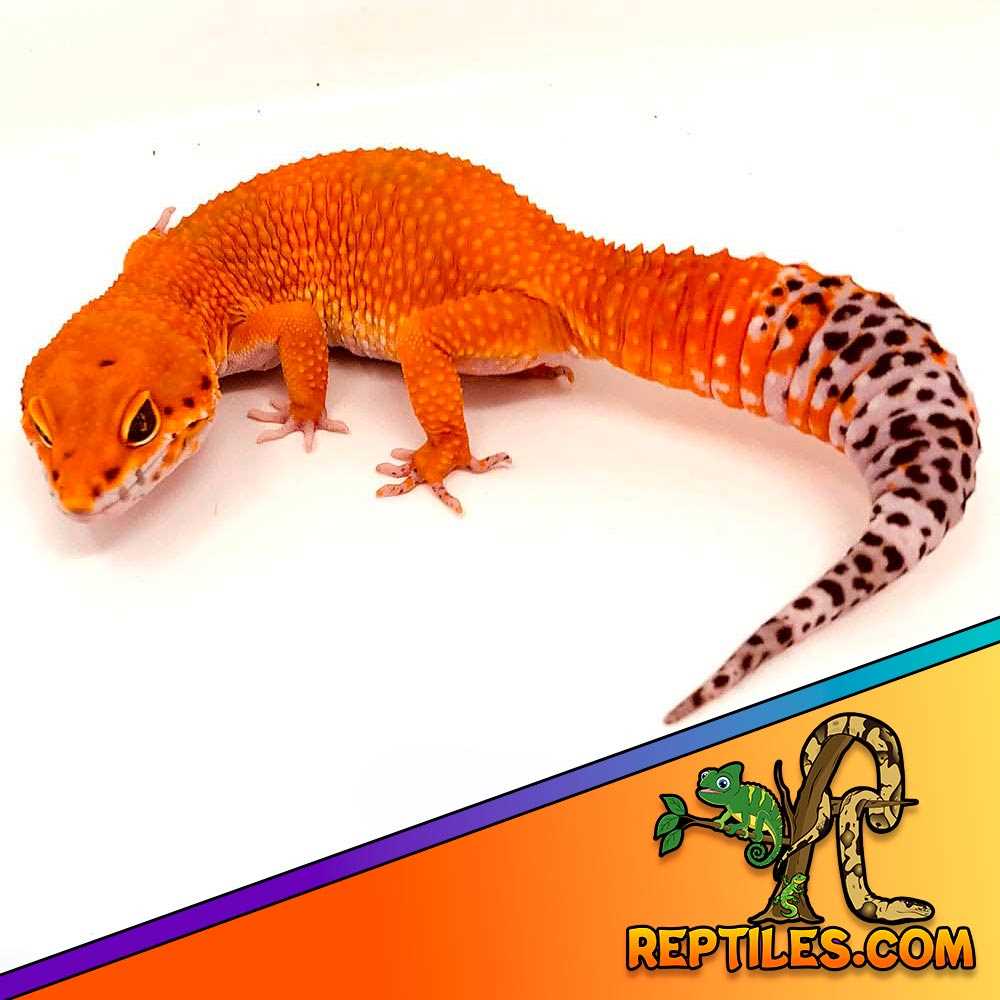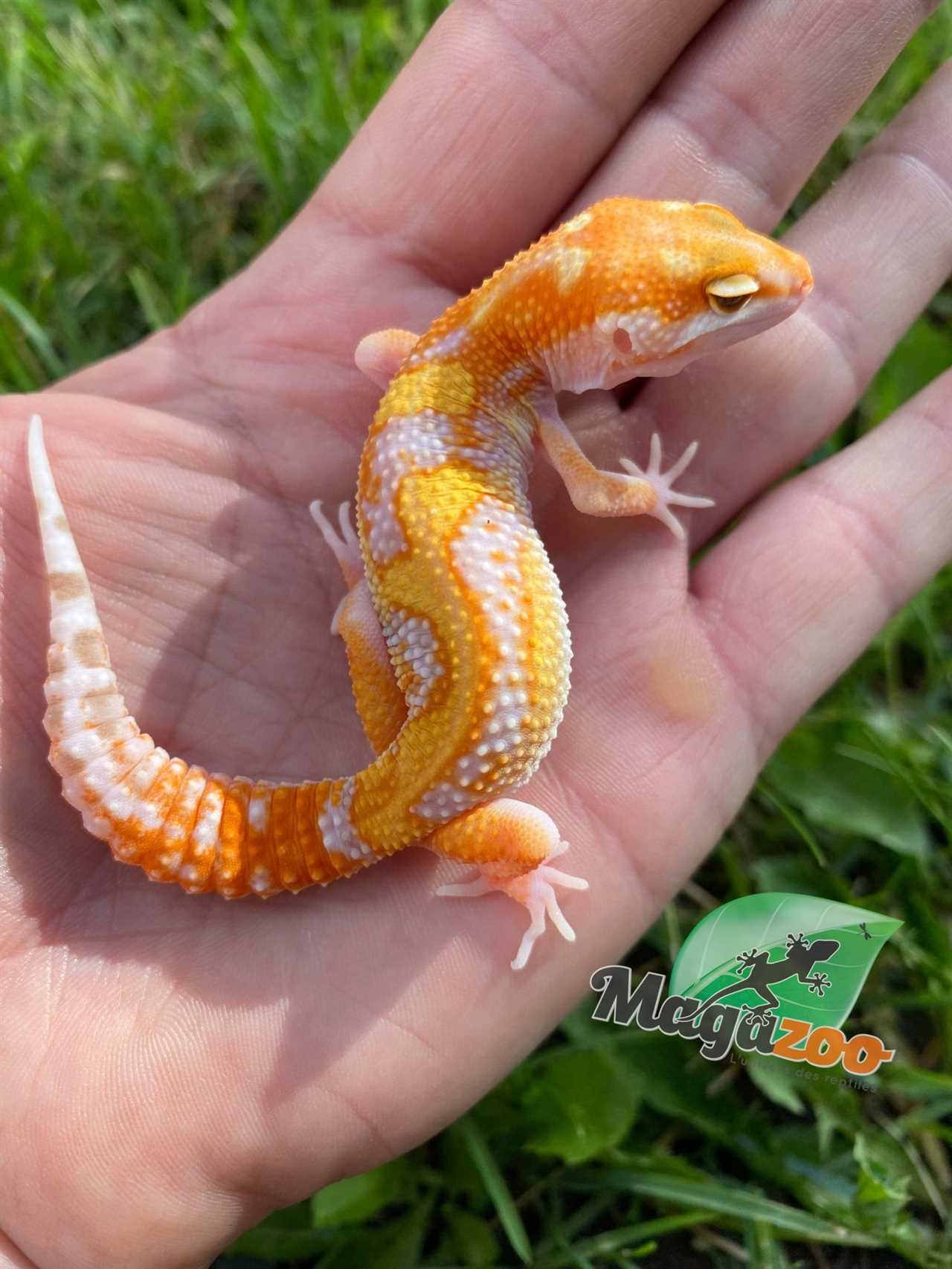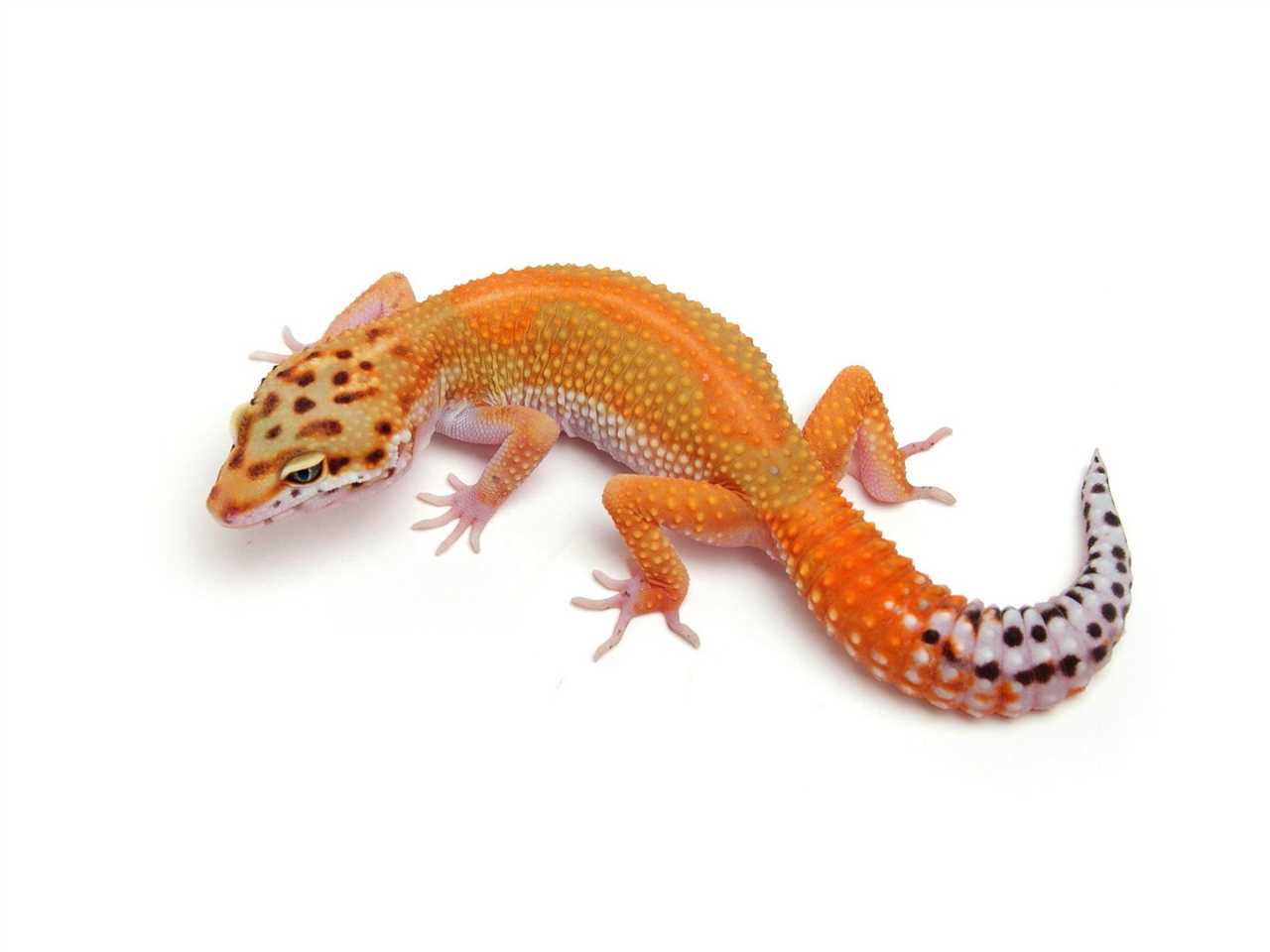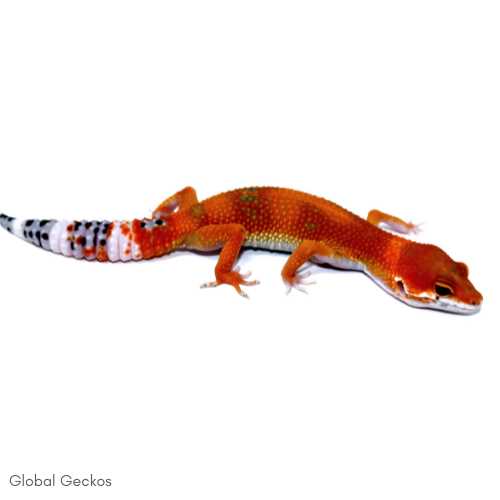The red leopard gecko is a mesmerizing reptile known for its vibrant red coloration and stunning leopard-like spots. This gecko belongs to the Eublepharis macularius species, which is native to the arid regions of Afghanistan, Iran, and Pakistan.
In addition to their red coloration, these geckos also possess distinct leopard-like spots on their bodies, giving them their name. These spots are typically black or brown and are scattered across the gecko’s head, body, and tail. The pattern and density of these spots can vary among individuals, making each gecko unique.
The red leopard gecko is a small reptile, measuring around 7 to 10 inches in length when fully grown. It has a stout body and large, lidless eyes, characteristic of the Eublepharis species. Unlike many other gecko species, the red leopard gecko cannot climb walls or glass due to its lack of specialized adhesive toe pads.
In the wild, red leopard geckos are nocturnal creatures, which means they are most active during the night. However, in captivity, they can adapt to diurnal patterns with proper lighting and a regular feeding schedule.
Overall, the red leopard gecko is a captivating reptile with its stunning red color, leopard-like spots, and friendly temperament. Whether you’re a first-time gecko owner or a seasoned reptile enthusiast, this species is sure to captivate you with its unique beauty and charm.
Habitat and Environment
The habitat and environment of red leopard geckos play a crucial role in their overall health and well-being. Creating a suitable habitat will ensure that your geckos thrive and live a long, happy life.
Temperature and Humidity
A heating pad or under-tank heater can be used to maintain the temperature gradient. Make sure to provide a cool area in the enclosure, as well as a hiding spot, where the geckos can retreat to if they feel too warm.
The humidity level for red leopard geckos should remain low, between 10% and 30%. High humidity can lead to respiratory infections or skin problems. To maintain the appropriate humidity level, a shallow water dish can be provided, but it should be cleaned regularly to prevent bacterial growth.
Enclosure Setup
A 20-gallon terrarium is suitable for a pair of red leopard geckos. The enclosure should be escape-proof, with a secure lid or screen top. A substrate of reptile carpet, paper towels, or slate tiles can be used for the enclosure floor, as it is easy to clean and reduces the risk of impaction.
Provide plenty of hiding spots, such as rocks, logs, or commercially available hides. These will give your geckos a sense of security and privacy. Additionally, provide branches or ledges for climbing and a shallow dish for water.
Lighting
Leopard geckos are nocturnal creatures and do not require UVB lighting. However, they do need a light cycle to maintain their circadian rhythm. Using a low-wattage incandescent bulb or a nocturnal reptile heat lamp for 12-14 hours a day will provide the geckos with a day-night cycle.
Avoid using bright white lights or exposing the geckos to direct sunlight, as it can cause stress and lead to health problems.
By creating a suitable habitat and environment for your red leopard geckos, you are ensuring their overall well-being and promoting their natural behaviors. Taking the time to set up the perfect enclosure will result in happy and healthy geckos.
Feeding and Nutrition for Red Leopard Geckos
Types of Food
The main food sources for red leopard geckos are crickets, mealworms, and Dubia roaches. These insects should be gut-loaded, which means feeding them with a nutritious diet before being offered to the geckos. Gut-loading ensures that the insects provide optimal nutrition to the geckos.
Feeding Schedule
Adult red leopard geckos should be fed every other day. Offer them 5-7 appropriately sized insects per feeding. It is best to feed them in the evening or early morning when they are most active. Be sure to remove any uneaten insects within a few hours to prevent them from bothering the gecko or affecting the enclosure’s cleanliness.
For younger geckos and hatchlings, daily feedings are recommended. They have higher metabolisms and need more frequent meals to support their growth.
Dusting and Supplementation
To ensure that red leopard geckos receive all the necessary vitamins and minerals, it is crucial to dust their food with calcium powder. You can purchase specific reptile calcium powder from pet stores. Place a small amount of the calcium powder in a plastic bag and gently shake the insects in it before feeding them to the gecko.
In addition to calcium powder, you can also provide a vitamin supplement containing vitamins A, D3, and E. However, be cautious not to over-supplement, as excessive amounts of certain vitamins can be harmful to the geckos. Follow the instructions provided on the supplement packaging.
Water
Always provide a shallow dish of fresh, clean water for the gecko. Make sure to place the dish in an easily accessible location within the enclosure. It is essential to change the water daily to prevent bacterial growth or contamination.
Red leopard geckos generally obtain most of their hydration from the insects they consume, but having a water source available is still important.
By following these feeding and nutrition guidelines, you can ensure that your red leopard gecko remains healthy, active, and vibrant in color.
Essential Care and Maintenance for Red Leopard Gecko
Habitat Setup
The first step in caring for a red leopard gecko is to set up a suitable habitat. You will need an enclosure that provides enough space for the gecko to move around comfortably. A 20-gallon tank is usually sufficient for one adult gecko.
The tank should have a secure lid to prevent escapes and maintain a stable temperature and humidity level. A substrate such as reptile carpet or paper towels can be used for the bottom of the tank, as it is easy to clean and reduces the risk of impaction.
It’s also important to include a shallow water dish for the gecko to drink from and soak in if desired. Make sure to clean and refill the water dish regularly to prevent the build-up of bacteria.
Temperature and Lighting

Red leopard geckos are ectothermic, which means they rely on external heat sources to regulate their body temperature. Provide a temperature gradient in the enclosure, with a warm side and a cool side.
The warm side should be maintained at around 88-90°F (31-32°C) during the day, while the cool side can be kept between 75-80°F (24-27°C). This can be achieved by using an under-tank heating pad or a heat lamp. Use a digital thermometer to monitor the temperature and make adjustments as necessary.
Unlike some other reptiles, red leopard geckos do not require UVB lighting. They can obtain all the necessary vitamin D3 and calcium from a proper diet. However, providing a low-level light source during the day can help simulate their natural environment.
Feeding and Nutrition
Feed juvenile geckos daily, while adult geckos can be fed every other day or a few times a week. Make sure to remove any uneaten insects from the enclosure to prevent them from bothering the gecko or causing health issues.
Cleaning and Maintenance
Regular cleaning and maintenance are essential for the health and hygiene of your red leopard gecko’s habitat. Remove any feces or shed skin promptly to prevent the build-up of bacteria. Clean the water dish regularly with mild soap and water.
The substrate should be spot-cleaned as needed and completely changed every 2-4 weeks. Thoroughly clean the tank and all decorations with a reptile-safe disinfectant every few months to remove any potential bacteria or parasites.
Additionally, monitor the humidity levels in the enclosure using a hygrometer. Aim for a humidity level of around 30-40%, which can be achieved by lightly misting the tank with water a few times a week.
By providing proper care and maintenance, you can ensure the health and well-being of your red leopard gecko. Regularly monitor their behavior and appearance for any signs of illness or stress and consult a veterinarian if needed.
Health and Common Diseases

Lastly, leopard geckos can also suffer from respiratory infections, which can be caused by a combination of poor environmental conditions and a weakened immune system. Providing a clean and well-ventilated habitat and avoiding sudden temperature changes can help prevent respiratory issues. If your gecko does develop a respiratory infection, seek veterinary care as soon as possible.
Breeding Red Leopard Geckos

1. Prepare a Breeding Pair: Selecting the right geckos for breeding is crucial. You should choose healthy adults that are at least 12 months old and have reached sexual maturity. It is recommended to pair a male gecko with one or more females to increase the chances of successful breeding.
2. Create the Ideal Environment: Red leopard geckos require specific temperature and humidity levels for successful breeding. Provide a suitable enclosure with a warm side and a cool side, allowing the geckos to regulate their body temperature. Additionally, ensure that the enclosure has appropriate hiding spots and a moist hide for the female gecko to lay her eggs.
3. Introduce the Pair: When introducing the male and female geckos, closely monitor their behavior. The male will typically display courting behavior, such as tail waving and head bobbing, to attract the female. Once the female is receptive, mating will occur. It is essential to provide ample space for the geckos to mate comfortably.
4. Egg-Laying: After successful mating, the female gecko will lay her eggs. Provide her with a suitable egg-laying box filled with moist substrate, such as vermiculite or perlite. The female will dig a burrow in the substrate and deposit her eggs. Ensure that the eggs are carefully removed from the enclosure to prevent any damage.
5. Incubation: The collected eggs should be gently cleaned and placed in an incubator. Maintain the temperature and humidity levels according to the species’ requirements. The eggs will typically hatch within 45-60 days, depending on the incubation conditions and genetics.
6. Raising the Hatchlings: Once the eggs have hatched, the hatchlings should be separated into their individual enclosures to prevent any aggression or cannibalism. Provide them with appropriate heating, hiding spots, and a balanced diet of small insects. Regularly monitor their growth and development to ensure they are thriving.
Breeding red leopard geckos requires patience, knowledge, and a passion for these incredible creatures. By following the proper breeding techniques and providing the necessary care, you can contribute to the conservation and preservation of this beautiful reptile species.
Selecting and Pairing Geckos
Age is another important factor to consider. It is recommended to wait until the geckos are at least one year old before attempting to breed them. This ensures that they have reached sexual maturity and are able to produce healthy offspring.
Prior to pairing, it is recommended to provide optimal conditions for breeding. This includes maintaining the appropriate temperature and humidity levels in the enclosure, as well as ensuring a comfortable and spacious environment for the geckos to mate.
Incubation and Hatching
Incubation is a crucial stage in the breeding process of red leopard geckos. It is during this time that the eggs develop and eventually hatch into adorable hatchlings. Proper incubation conditions and techniques are essential for ensuring the health and survival of the eggs.
The incubation container should be filled with a suitable incubation medium, such as vermiculite or perlite. This medium provides the necessary moisture and support for the eggs during development. The container should be labeled with the date the eggs were laid and the parent geckos’ information to track the incubation period.
The temperature and humidity inside the incubation container play a crucial role in the development of the eggs. The ideal temperature for incubating red leopard gecko eggs is around 82 to 86 degrees Fahrenheit (28 to 30 degrees Celsius). Maintaining a consistent temperature throughout the incubation period is essential.
To achieve the desired temperature, an incubator or heat source can be used. Many breeders use specialized incubators designed for reptile eggs. These incubators often have built-in temperature and humidity controls, allowing for precise adjustments.
The humidity inside the incubation container should be maintained around 80 to 90%. This can be achieved by spraying the incubation medium with water when necessary. Regular monitoring of the humidity levels is important to prevent the eggs from drying out or becoming too moist.
A separate hatching container should be prepared with a suitable substrate, such as paper towels or reptile carpet. The humidity inside the hatching container should be slightly higher than during incubation, around 90 to 95%. This can be achieved by placing a water dish or moist paper towel in the container.
The hatchlings should be provided with a suitable hiding spot and a shallow water dish for hydration. They should also be offered appropriate-sized food, such as small insects, within the first 24 hours of hatching.
Proper incubation and hatching techniques are essential for successfully breeding red leopard geckos. By providing the ideal conditions and closely monitoring the eggs, breeders can ensure the health and survival of the hatchlings, contributing to the fascinating world of red leopard gecko breeding.
Raising and Caring for Hatchlings
Once the red leopard gecko hatchlings have emerged from their eggs, they require proper care in order to thrive and grow. Here are some important tips for raising and caring for these small geckos:
1. Housing
Provide a suitable enclosure for the hatchlings, such as a small terrarium or reptile tank. Make sure the enclosure is escape-proof and provides enough space for the geckos to move around.
2. Temperature and Lighting
Maintain the proper temperature range in the enclosure, typically between 80-85°F (26-29°C) during the day and slightly cooler at night. Use a heat source, such as an under-tank heater or heat lamp, to achieve the optimal temperature. Additionally, provide a UVB light source to ensure the geckos receive adequate exposure to ultraviolet light.
3. Substrate
Choose a suitable substrate for the enclosure, such as paper towels, reptile carpet, or slate tiles. Avoid using loose substrates that can be ingested by the hatchlings and cause impaction.
4. Feeding
Feed the hatchlings a diet consisting of appropriately-sized live insects, such as small crickets or mealworms. Dust the insects with a calcium supplement before offering them to the geckos. Offer food every day or every other day, ensuring that the hatchlings are consuming enough to support their growth.
5. Water and Hydration
Provide a shallow dish of fresh water in the enclosure at all times. Ensure that the water is clean and easily accessible for the hatchlings to drink from. Mist the enclosure regularly to maintain humidity levels and provide additional hydration for the geckos.
6. Handling
Handle the hatchlings with care and avoid excessive handling, especially in the early stages. Allow them time to acclimate and settle into their new environment before attempting to handle them. When handling, support their body with gentle and secure movements.
Genetics and Color Morphs
Red leopard geckos can come in various color morphs, including solid red, tangerine, carrot tail, and blood red. These morphs are the result of different combinations of genes that affect pigmentation and scale color.
Basic Genetics
One of the most important genes in red leopard geckos is the Tangerine gene. This gene is responsible for producing the vibrant orange coloration seen in many morphs. When bred together, geckos carrying the Tangerine gene can produce offspring with an even stronger orange color.
Color Morphs
There are several different color morphs that can be found in red leopard geckos. These morphs are the result of various genetic combinations and can range from bright red to deep crimson. Some popular color morphs include:
- Tangerine: This morph displays vibrant orange coloration throughout the body.
- Carrot Tail: This morph features a deep orange coloration concentrated in the tail.
- Blood Red: This morph has a deep red coloration, resembling blood.
- Solid Red: This morph displays a consistent red coloration across the entire body.
Selective Breeding

Selective breeding plays a crucial role in creating and preserving specific color morphs in red leopard geckos. Breeders carefully choose pairs of geckos based on their genetics to produce offspring with desired traits.

I’m Lena Adams—a product of an unconventional upbringing in the African wilderness. My father, a daring explorer of African wildlife, sparked my fascination with reptiles, a passion that intertwined with the tragic loss of my mother during an expedition, leaving an indelible mark on my life. Driven to understand the creatures that captivated my parents, I embarked on my journey, sharing insights about reptiles, frogs, and lizards on my website. Through my explorations and conservation efforts, I honour my family’s legacy while seeking connections—to the creatures, nature, and the mother whose presence I yearn to understand.
